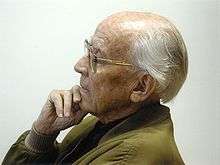Immortal Bach
Immortal Bach, Op. 153, is a choral composition from 1988 by Knut Nystedt, derived from the first line of Bach's funeral song "Komm, süßer Tod" (Come, sweet death). He scored it for mixed choir a cappella divided among many individual voices.
| Immortal Bach | |
|---|---|
| by Knut Nystedt | |
 The composer in 2007 | |
| Catalogue | Op. 153 |
| Language | Latin |
| Based on | "Komm, süßer Tod" |
| Composed | 1987 |
| Published | 1988 |
| Vocal | SATB choir |
Background
The Norwegian composer Knut Nystedt grew up in a Christian family, where hymns and classical music were part of everyday life.[1] In 1950, he founded a vocal ensemble, Det Norske Solistkor, which he conducted until 1990.[2] Among his roughly 300 choral compositions, which account for three quarters of his works,[3] he wrote several pieces of sacred music, including De Profundis, Op. 54, a 1966 setting of Psalm 130, and Missa brevis, Op. 102, in 1984. In 1987, he derived Immortal Bach from the first line of Johann Sebastian Bach's setting of the funeral song "Komm, süßer Tod".[1][2][4] It was published in 1999 by Norsk Musikforlag in Oslo.[5] Immortal Bach was the last piece Nystedt conducted with Det Norske Solistkor before he retired.[2]
Music
Immortal Bach is an arrangement of the first line of Bach's four-part setting of the funeral song "Komm, süßer Tod".[6] The song for a singer and basso continuo appeared in Schemellis Gesangbuch, BWV 478. The text of the first eight measures which Nystedt used is "Komm, süßer Tod. Komm, sel'ge Ruh'. Komm führe mich in Friede." (Come, sweet death. Komm, blessed rest. Come and lead me to peace.)[7] Nystedt harmonised the bassline to a four-part setting a cappella. The choir first sings this setting. What follows is an arrangement scheme, according to which the singers perform the same music, but in different tempo.[4] In the first and third phrase, all voices begin together and hold the first note for a long time until each voice moves forward in different tempo, and all wait at the end of the phrase until united again. The second phrase is treated slightly differently: the sopranos alone enter on a forceful high note, while the lower voices enter together later, then proceeding as in the other phrases. The work begins and ends pianissimo.[7] Nystedt recommended to place the singers surrounding the audience.[7]
Vladimir Morosan, an Russian composer and musicologist with a focus on sacred choral music,[8] wrote liner notes for Hyperion Records and described the result as "theology expressed in sound", giving meaning to the phrase "time-less", and as a "glimpse ... of eternity".[6]
Recordings
Nystedt's vocal ensemble, Det Norske Solistkor, recorded music by Bach and Nystedt in 2015, conducted by Grete Pedersen, concluding with Immortal Bach. A reviewer called the piece "an amazingly challenging essay in soft, sustained vocal sound".[2]
References
- "Knut Nystedt" (in German). Diocese of Cologne. 2003. Retrieved 26 May 2019.
- Quinn, John (February 2016). "Meins Lebens Licht / Knut Nystedt (1915–2014)". musicweb-international.com. Retrieved 13 July 2019.
- "Nystedt Chamber and Vocal Works". Gramophone. 1993. Retrieved 2 June 2019.
- "Immortal Bach" (PDF). aetheria.ru (in German). Retrieved 7 July 2019.
- OCLC 672030640
- Morosan, Vladimir (1997). "Immortal Bach". Hyperion Records. Retrieved 7 July 2019.
- "Musikstück der Woche mit dem SWR Vokalensemble / Bach durch den Klangvorhang" (in German). SWR. 21 August 2017. Retrieved 13 July 2019.
- Vladimir Morosan: Setting Liturgical Texts to Music oca.org